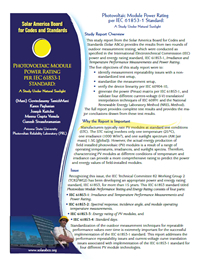
Photovoltaic Module Power Rating per IEC 61853-1 Standard:
A Study Under Natural Sunlight
Download the one-page summary (PDF, 344KB) or the full report (PDF, 2.52MB).
Overview

This overview summarizes a Solar America Board for Codes and Standards (Solar ABCs) report that provides the results from two rounds of outdoor measurement testing, which addresses five objectives related to the International Electrotechnical Commission (IEC) power and energy rating standard, IEC 61853-1, Irradiance and Temperature Performance Measurements and Power Rating. The objectives for this report are to:
- Identify measurement repeatability issues with a non-standardized test setup,
- Standardize the measurement setup,
- Verify the device linearity per IEC 60904-10,
- Generate the power (Pmax) matrix per IEC 61853-1, and
- Validate four different current-voltage (I-V) translation/interpolation techniques of IEC 60891 and the National Renewable Energy Laboratory Method (NREL Method).
The full report provides the test results from two rounds of outdoor measurements and also provides the major conclusions based on the test results.
Why the Report is Important
Manufacturers typically rate PV modules at standard test conditions (STC). The STC rating involves only one temperature (25°C), one irradiance (1000 W/m2), and one sunlight spectrum (AM [air mass] 1.5G [global]). However, the actual energy production of field installed PV modules is a result of a range of operating temperatures, irradiances, and sunlight spectra. Therefore, there is an urgent need to characterize PV modules at different temperatures and irradiances to provide more comprehensive rating information.
Issue
Recognizing this issue, the IEC Technical Committee 82 Working Group 2 (TC82/WG2) has been developing an appropriate power and energy rating standard, IEC 61853, for more than 15 years. This IEC 61853 standard titled "Photovoltaic Module Performance Testing and Energy Rating" consists of four parts, including:
- IEC 61853-1: Irradiance and Temperature Performance Measurements and Power Rating, which describes requirements for evaluating PV module performance in terms of power (watts) rating over a range of irradiances and temperatures;
- IEC 61853-2: Spectral response, incidence angle, and module operating temperature measurements, which describes test procedures for measuring the effect of varying angle of incidence and sunlight spectra as well as the estimation of module temperature from irradiance, ambient temperature, and wind speed;
- IEC 61853-3: Energy rating of PV modules, which describes the calculations for PV module energy (watt-hours) ratings; and
- Standard days, which describes the standard time periods and weather conditions that can be used for the energy rating calculations.
This report addresses the IEC 61853-1, which specifies the performance measurements of PV modules at 23 different sets of temperature and irradiance conditions, using either a solar simulator (indoor) or natural sunlight (outdoor). Validation of the current outdoor techniques for repeatability over time within the same laboratory and for reproducibility among multiple laboratories is extremely important for the successful implementation of this standard.
Solar America Board for Codes and Standards Conclusions
Below are the major conclusions corresponding to the five objectives for this report:
- Outdoor measurement repeatability issues: The repeatable power rating measurements at various irradiance levels under natural sunlight within an acceptable deviation limit of 2% could not be achieved when uncalibrated mesh screens were placed directly (0-inch distance) on the test module and reference cell.
- Standardization of measurement setup: A standardized measurement setup was established with reference cells kept outside the calibrated mesh screens, which were placed at a 2-inch distance above the test modules.
- Verification of device linearity per IEC 60904-10: The linearity requirements of open-circuit voltage, short-circuit current, and maximum power versus temperature are met by all four test technologies. Similarly, the linearity requirement of open-circuit voltage versus the logarithm of irradiance is also met (with two minor exceptions presumably due to some experimental errors) by all four test technologies. For the short-circuit current versus irradiance, the devices met the linearity requirement (2% deviation limit) for irradiance levels above 200 W/m2 but they surprisingly showed a higher deviation for the irradiance levels below 200 W/m2. This higher deviation was objectively attributed to some minor experimental errors related to the calibration of low transmittance mesh screens under natural sunlight.
- Generation of Pmax matrix per IEC 61853-1: The required 23-element Pmax matrix of IEC 61853-1 was successfully generated for all four module technologies using the four translation/interpolation procedures of IEC 60891 and the NREL Method. Unless the data processing personnel pay extreme attention or commercial test laboratories automate the data processing, the translation procedures (1 and 2) are more prone to human error than the interpolation procedures (3 and 4). However, procedures 1 and 2 would work extremely well if multiple narrow irradiance ranges are used with individual sets of correction values for each narrow irradiance range or multiple sets of correction values are used for a single wide irradiance range.
- Validation of procedures of IEC 60891 and the NREL Method: An extensive validation analysis of the four translation/interpolation procedures, at both narrow and wide irradiance ranges, indicates that all the four procedures are remarkably accurate within an average error of 3% and a root mean square error (RMSE) of 4.5%.